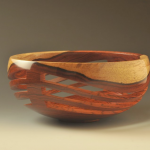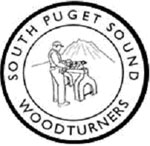

I enjoy including a certain “how did he do that?” factor into my pieces while staying true to good design. Having lived my entire life near the Pacific Ocean, the motion and rhythm of the ocean’s waves are a major inspiration for my work. Contrast is also an important element for me, not only aesthetically but in the process of turning a functional object, like a bowl, into an “object d’art.” Artistically, I like to combine multiple woods with dyes and textures to enhance the rhythmic lines that are a part of my work. The technical genesis of these works lies in my ability to deconstruct and reconstruct a turned vessel in a number of different ways while maintaining grain and wall alignment. I hope that my pieces will evoke a feeling of movement and energy in an otherwise static environment.
If that has you intrigued, read on about his plan for the day.
While the focus of my demonstration is on my unique “wave” technique, my goal is for the audience to see a lot of tips and tricks that can be applied to their own designs. The genesis of my work comes from the ability to deconstruct and reconstruct a turned vessel in a number of different ways while maintaining grain and wall alignment. The advantage of my technique is it allows the turner to begin with wet logs and still build constructed turnings.
1. Introduction
Powerpoint presentation showing the evolution of my work and talk about design.
2. Creating The Wave
From a small block of dry wood I show the basic technique behind my “wave” design. I mark and
freehand cut the block on a bandsaw, glue one layer “wave” into it, and then turn it into a bowl.
Additional Tips and Tricks:
- steam bending with a microwave
- tips for keeping the block aligned when reassembling
- importance of grain direction
3. Protruding Wave
From a rough turned and dried bowl, I show the jig I made and demonstrate the steps I use to turn a
bowl with a protruding wave from one piece of wood. The jig can also be used for many other
applications that might not include my wave design. This is followed by discussion on how I accomplish some of the other implementations of my “wave” design.
Additional Tips and Tricks:
- how to keep a deconstructed bowl aligned for reassembling
- how to set depth stops for turning part of a bowl smaller
- how to clamp and glue a deconstructed bowl back together
- cleaning up glue squeeze out
- cutting curves in non backed veneer with no splitting
4. Flying Rib Vase
From a rough turned end grain vase, I show how I use my jig to cut the vase apart, add the protruding ribs and reassemble the vase.
Additional Tips and Tricks.
- clamping and gluing a round object
- how to achieve perfect joints for gluing
[note]Unable to attend the all-day demo with John Beaver. Don’t fret because you will have the opportunity to see John as the demonstrator at our membership meeting on April 19th.[/note]
Cost for this all-day demo with John Beaver is $30 if paid in advance. For additional information and to register contact SPSW Vice President Eric Lofstrom.

